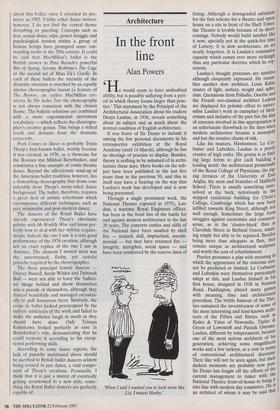Dance
Three's company
Giannandrea Poesio
Although the secret of a thriving ballet company is a varied, challenging repertoire, some traditionalists regard such an artistic policy as a threat to the stylistic identity of the company itself. In addition, new, unusual choreographic formulae — which, in turn, might require a training different from the one that the dancers are accus- tomed to — are often considered detri- mental to the quality of the dancing. The Royal Ballet's new triple bill, howev- er, demonstrates that stylistic identity and new formulae can easily co-exist and com- plement each other, thus offering stimulat- ing possibilities for the numerous talents of the company. In addition, the programme is beautifully structured, presenting three different notions of contemporary ballet.
Created in 1983, David Bintley's Consort Lessons belongs to that fortunate series of abstract works with which the choreogra- pher demonstrated both his intent and his ability to develop a well-affirmed British tradition. The perfect symmetry of the choreographic layout, the geometric use of the body lines and the apparent discrepan- cy between the jazz-like quality of Stravin- sky's score and the refined neo-classical purity of the dancing refer, more or less directly, to a not so distant past, when these were the distinctive features of the so-called English style. Yet the ballet is far from being a mere compendium of past ideas. Although sporadic references to dances created by some of Bintley's illustri- ous predecessors punctuate the work, the choreography stands out through its many inventive solutions that are typically Bint- ley's, such as the particular use of the music and the unpredictable technical com- binations.
An unusual movement vocabulary is also the principal component of Kenneth MacMillan's The Judas Tree. I must admit that I have always had some reservations about this ballet, since I attended its pre- miere in 1992. Unlike other dance writers, however. I do not find the central theme disturbing or puzzling. Concepts such as fear, sexual abuse, rape, power struggle and psychological tension within a group of human beings have prompted some out- standing works in the 20th century. It could he said that MacMillan's ballet is the British answer to Pina Bausch's powerful Rite of Spring, Jerome Robbins's The Cage or the second act of Mats Ek's Giselle. In each of these ballets the intensity of the dramatic situation is matched by an equally intense choreographic layout (a feature of Thr Karroo, an earlier MacMillan cre- ation). In The Judas Tree the choreography is not always consistent with the chosen theme. The balletic solutions are combined with a more experimental movement vocabulary — which reflects the choreogra- pher's creative genius. This brings a stilted result and detracts from the dramatic crescendo.
Push Comes to Shove is probably Twyla Tharp's best-known ballet, mainly because it was created, in 1976, as a showcase for the Russian star Mikhail Baryshnikov, and constitutes a fine example of comic theatre dance. Beyond the affectionate send-up of the American ballet tradition, however, lies a demanding choreography that draws con- siderably from Tharp's many-sided dance background. The ballet, therefore, requires a great deal of artistic eclecticism which encompasses different techniques, such as jazz, minimalist and post-modern dance.
The dancers of the Royal Ballet have already experienced Tharp's chromatic palette with Mr Worldly Wise and know per- fectly how to deal with her stylistic require- ments. Indeed, the one I saw is a very good performance of the 1976 creation, although not an exact replica of the one I saw in America. The element I missed most was the unrestrained, flashy, yet tasteful panache required by the choreographer.
The three principal female dancers — Darcey BuSsell, Sarah Wildor and Deborah Bull — were not able to leave the 'balleri- na' image behind and throw themselves into a parody of themselves, although they danced beautifully and managed occasion- ally to pull humorous faces. Similarly, the corps de ballet looked preoccupied by the stylistic intricacies of the work and failed to make the audience laugh as much as they should have done. Only Tetsuya Kumakawa looked perfectly at ease in Baryshnikov's role, demonstrating that he could recreate it according to his excep- tional performing skills.
According to some dance experts, the lack of panache mentioned above should he ascribed to British ballet dancers seldom being trained in jazz dance, a vital compo- nent of Tharp's creations. Personally, I think that it is just a matter of eventually getting accustomed to a new style, some- thing the Royal Ballet dancers are perfectly capable of.



























































 Previous page
Previous page